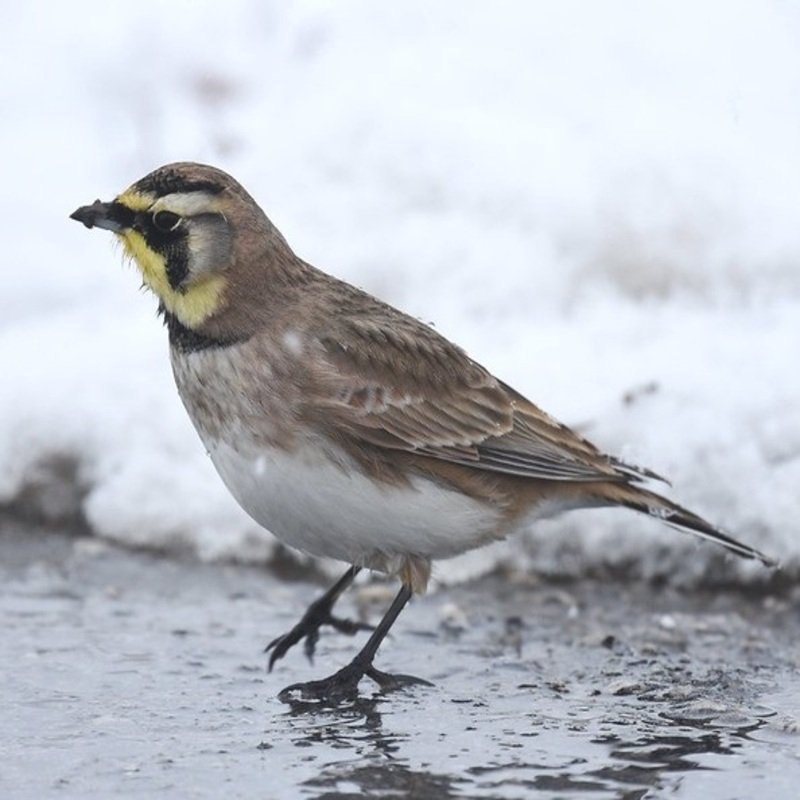Larks of the Alaudidae family, including the horned lark, Eremophila alpestris in Latin, which is known as the beach lark in Europe, are a type of lark that may be found across the northern hemisphere.
Quick Overview: Eremophila Alpestris – Horned Lark
Body size: Around 7-8 in (18-20 cm) and a weight of 31 g (1.1 oz)
Main colors: Black, White, Yellow, Brown, Gray
Range: Throughout the United States
Migratory Bird: Yes
Best time of the year to see in the U.S.: All Year (January – December)
Conservation Status: Least Concern
Horned lark Description
The horned lark’s most distinctive physical feature is a pair of black feather tufts on the crown. The tufts resemble horns. The bill, eye, and side of the head are generally black with a white or light yellow stripe. A black spot on the breast and a brown body. A long, straight claw is on the hind toe. The claw or ‘larkspur’ is a typical feature of larks. Females exhibit similar patterns to males, but are smaller, duller, and have gray instead of black in certain spots. Males average 32 g, females 30.6 g.

Size
These birds have a length of 7-8 in (18-20 cm) and a weight of 31 g (1.1 oz). Their wings could range from 12.5-14 in (32-36 cm).
Feeding
Horned lark forages for food in open areas. It doesn’t fly about looking for food, but rather searches on foot. Unless nesting, it generally hunts for food with its flock. Horned larks eat anything. They eat insects including spiders, ants, grasshoppers, and wasps. They consume snails and certain plant fruits, berries, and seeds.
Habitat
Horned lark is a temperate species that loves wide ground free of trees. It inhabits plains, prairies, and arid tundra. Airports, for example, are known to have horned larks. They usually live on the ground.
Behavior
Horned lark can dwell in flocks with other species. Flocking is especially common in coastal communities. Some horned larks are lone. Some horned lark populations are stationary, although most migrate south for the winter. Males employ “song flying” to attract mates and protect territory.
Eremophila alpestris Scientific Classification
- Kingdom: Animalia
- Phylum: Chordata
- Subphylum: Chelicerata
- Class: Aves
- Order: Passeriformes
- Family: Alaudidae
- Genus: Eremophila
- Species: Eremophila alpestris
Subspecies
There are forty-two (42) identified sp
Other common names
Also known as the beach lark.
Best time of the year to see
In the United States, the best time of year to see these birds is all year round, regardless of the season. This refers to any month of the year between January and December
Distribution of the Horned lark in the USA
Horned lark is found in North America, Asia, and northern Europe. Western, central, and eastern United States (including Alaska), northern and southern Canada. While some move to the Gulf Coast for the winter, many stays put all year.
The Horned lark can be found in the following states in the United States – Alabama, Arizona, Arkansas, California, Colorado, Connecticut, Delaware, Florida, Georgia, Hawaii, Idaho, Illinois, Indiana, Iowa, Kansas, Kentucky, Louisiana, Maine, Maryland, Massachusetts, Michigan, Minnesota, Mississippi, Missouri, Montana, Nebraska, Nevada, New Hampshire, New Jersey, New Mexico, New York, North Carolina, North Dakota, Ohio, Oklahoma, Oregon, Pennsylvania, Rhode Island, South Carolina, South Dakota, Tennessee, Texas, Utah, Vermont, Virginia, Washington, West Virginia, Wisconsin and Wyoming.
